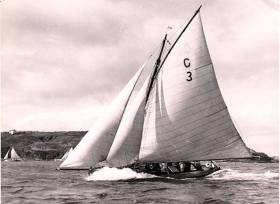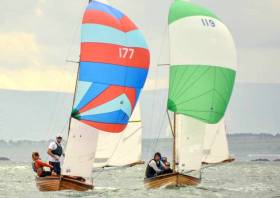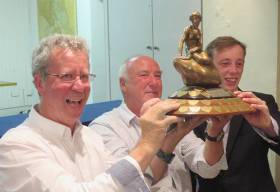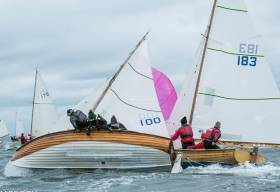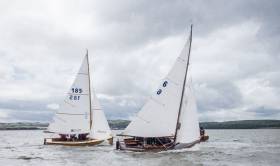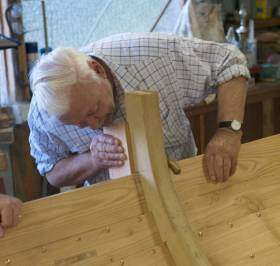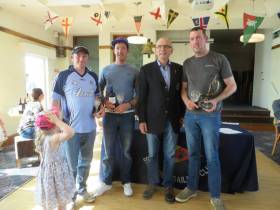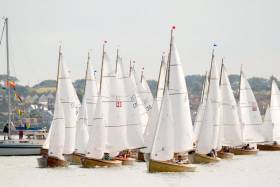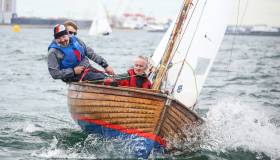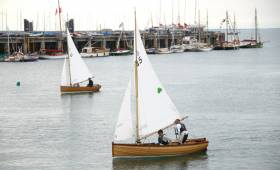Displaying items by tag: Mermaid
Ireland’s Contribution to the International Classic Wooden Boat Movement
The traditional and classic wooden boat-building movement is gaining momentum in many parts of the world. It can be part of educational and training schemes which provide skills and purpose in life, usually for young people but also for older folk seeking a new and very absorbing interest. Or it could be to preserve an indigenous boat type whose very survival is at risk. Then again, it may be for the simple pleasure of creating something which produces a tangible result from a satisfying personal project, or a worthwhile community effort. Whatever the reason, Irish sailing’s long history enables it to make a unique contribution to today’s proliferation of classic and traditional newly-built or restored craft emerging from workshops large and small in many parts of the world. W M Nixon looks at some aspects of a fascinating trend.
The half century or so between 1890 and 1945 will be seen by most historians as a period of exceptional global hostility, certainly as measured by the number of wars which were fought during it. So it’s remarkable that an activity like recreational sailing, which needs peaceful conditions to thrive, should have developed so much during that turbulent time.
Admittedly much of the development took place in the “Golden Era” between 1890 and the outbreak of World War I in 1914. But progress was being made in sailing for much of the rest of the period despite the often unfavourable conditions. And for Ireland, that historic time of progress is being reflected today in the number of historic designs for Irish classes which are now first choice for boat-building schools, and other special projects, in many countries including Ireland itself.
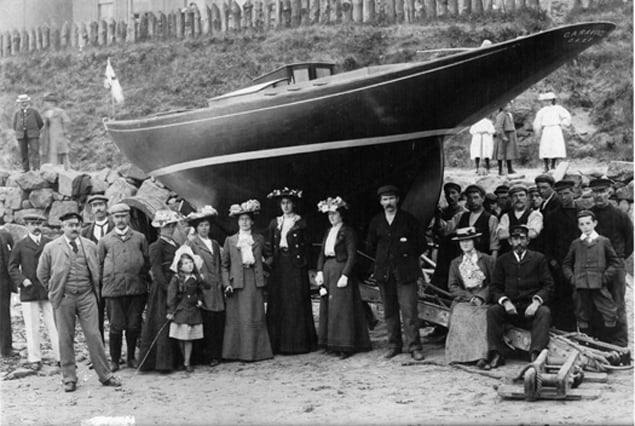 The Alfred Mylne-designed Dublin Bay 21 Garavogue, new-built and ready for launching by James Kelly of Portrush in 1903. Photo courtesy Robin Ruddock
The Alfred Mylne-designed Dublin Bay 21 Garavogue, new-built and ready for launching by James Kelly of Portrush in 1903. Photo courtesy Robin Ruddock
During that half century between 1895 and 1945 when many new local one design classes appeared, Ireland had a pioneering role, as the One Design concept had been first promoted by Thomas “Ben” Middleton’s Water Wags in Dublin Bay in 1887. Thus it was always an innovation which had special resonance in the Irish context, an ideal which it seemed only natural to follow.
Then too, the Royal Alfred YC of Dublin Bay had been promoting the virtues of amateur sailing since 1870 and earlier, so the level playing field provided by One-Designs was a natural follow-on for continuing such enthusiasm. But sustained and long-time support for a particular One-Design type – once it had proved itself satisfactory for the waters on which it sailed – also had much to do with the geography and social structure of Irish sailing.
Put simply, most sailors of the new and growing one design classes in Ireland lived in close proximity to where their boat were based and raced. In contrast elsewhere, thanks to the comprehensive 19th Century railway systems very effectively serving large conurbations such as London and Paris - and to a lesser extent Glasgow and New York - when the weekend was over, many owners and crews headed back to town, sometimes over quite long distances from their boat’s home port.
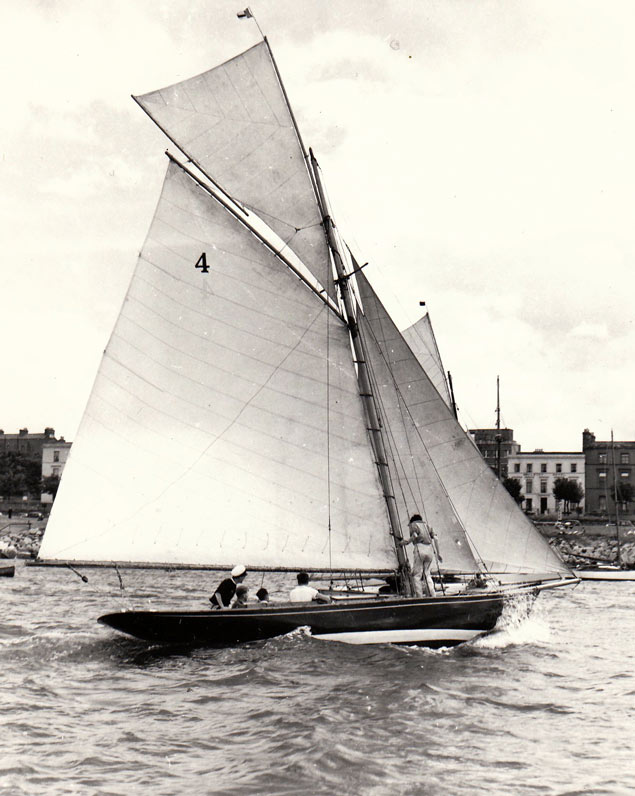 Garavogue in the final stages of a race when the finishes were still within Dun Laoghaire Harbour. Her owner and crew would have lived within easy reach of the harbour, and the comfortable social bonds within the DB21 class contributed to its long life from 1902 to 1986.
Garavogue in the final stages of a race when the finishes were still within Dun Laoghaire Harbour. Her owner and crew would have lived within easy reach of the harbour, and the comfortable social bonds within the DB21 class contributed to its long life from 1902 to 1986.
But in Ireland, whether it was Cork, Dublin or Belfast, the boat was always nearby, you might meet your fellow sailors quite often during the working week, and evening racing was an important part of the programme. In the greater Dublin area in particular, the cohesive nature of society meant that once a class was popularly established, it thrived so much that some boats from the late 1890s and early 1900s are still in existence and actively racing today.
This means that when a boat-building school seeks a meaningful design which will give added depth to their activities, they know they only have to turn to the wide selection of historic Irish classes to find a boat of suitable size which will have an element of international recognition, it will give those building her an encouraging sense of connection to the past for instructors and trainees alike, and at a practical level, they know there’ll be a diligent class measurer to keep them on track as the job progresses.
A further alternative technical element is added when the no-longer-seaworthy old hull of a revered classic is acquired, and it is then patiently analysed in a process which is a mixture of dissection, re-build and re-creation. Either way, whether building from scratch, or re-creating through various levels of re-building, the learning process is given many useful extra facets.
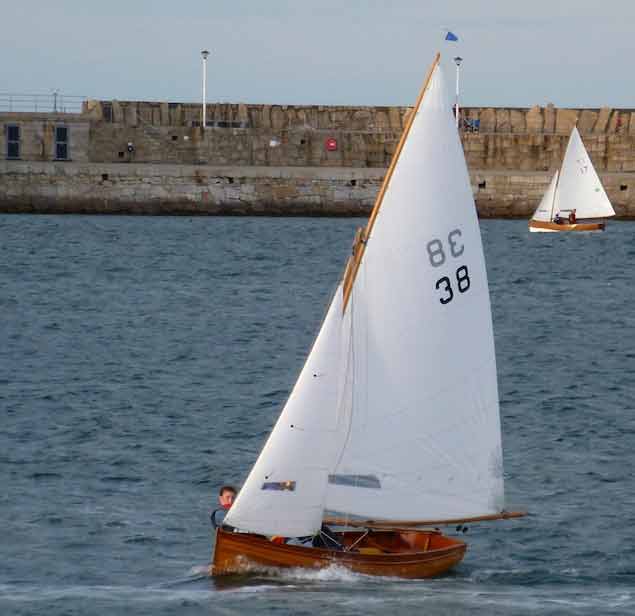 Water Wags in Dun Laoghaire Harbour. Founded as a class of 13-footers in 1887 and re-born in this larger 14ft 3in version by designer Maimie Doyle in 1900, they have become one of the most popular Irish classic designs for boat-building schools. Photo: W M Nixon
Water Wags in Dun Laoghaire Harbour. Founded as a class of 13-footers in 1887 and re-born in this larger 14ft 3in version by designer Maimie Doyle in 1900, they have become one of the most popular Irish classic designs for boat-building schools. Photo: W M Nixon
And as Irish sailors were not shy in asking designers of international repute to create their new One Designs for them, these re-build or new-build projects may have the added lustre of classic stardom with their undoubted historical significance. Thus in recent years while we may have had new boats being built to the old designs of Irish designers such as Maimie Doyle, Hebert Boyd, John B Kearney and O’Brien Kennedy, equally builders from abroad have been in touch with class associations and other sources in Ireland in order to re-create boats to the designs of William Fife and Alfred Mylne of Scotland, and Morgan Giles of England.
Thus at the moment we have Water Wags being built in Spain and America, Dublin Bay 24s are at various stages of being re-created in Spain, America and France, in France they have also built a Howth 17, another Water Wag and a Shannon One Design, it’s said there’s a Howth 17 being built in the boat-building training school attached to the US Naval Academy in Annapolis, and not surprisingly we hear of enquiries made of Irish class association from those havens of DIY boat-building enterprise, Australia and New Zealand.
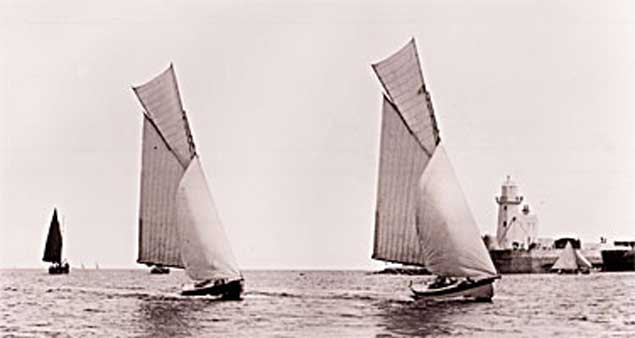 Two of the new Howth 17s in their first season in 1898, before sail numbers had been allocated.
Two of the new Howth 17s in their first season in 1898, before sail numbers had been allocated.
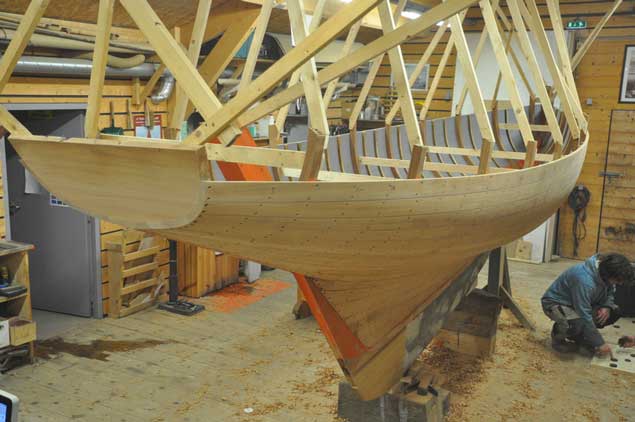 The Howth 17 Orla under construction at the Skol ar Mor boat-building school in France, May 2017
The Howth 17 Orla under construction at the Skol ar Mor boat-building school in France, May 2017
In fact, if we look at the range of living or still very well remembered classes in Ireland which have the potential to make designs available for such classics projects, the choice is remarkably comprehensive in size and type. They range through the 14ft IDRA 14s (O’Brien Kennedy, 1946), the 13ft and now 14ft 3ins Water Wags (R A MacAllister 1887 & Maimie Doyle 1900), the Castletownshend Ettes of the 1930s come in at 16ft, at 17ft you have both the Shannon One Designs (Morgan Giles 1922) and the Mermaids (John Kearney 1932), at 18ft we’re already into keelboats and the Belfast Lough Waverleys (John Wylie 1902), move up to 22ft and you have the Linton Hope-designed Fairy Class (1902) on both Belfast Lough and Lough Erne, and there were also the Fife-designed Belfast Lough Class IIIs of 1896, and then at 22ft 6ins there are the Howth 17s by Herbert Boyd (1898).
Up at 25ft there are the Glens (Alfred Mylne, 1945) in Dun Laoghaire Harbour and on Strangford Lough, and also on Strangford Lough at 28ft 6ins there are the Rivers (Alfred Mylne, 1920). Moving towards the 30-31ft mark, we have the Cork Harbour One Designs (William Fife 1896) and the Dublin Bay 21s (Alfred Mylne 1902), and finally above that, with all of them around the 37ft 6ins LOA size, are the Belfast Lough Class I (Fife 1897), the Dublin Bay 25s (Fife 1898) and the Dublin Bay 24s (Mylne, 1938).
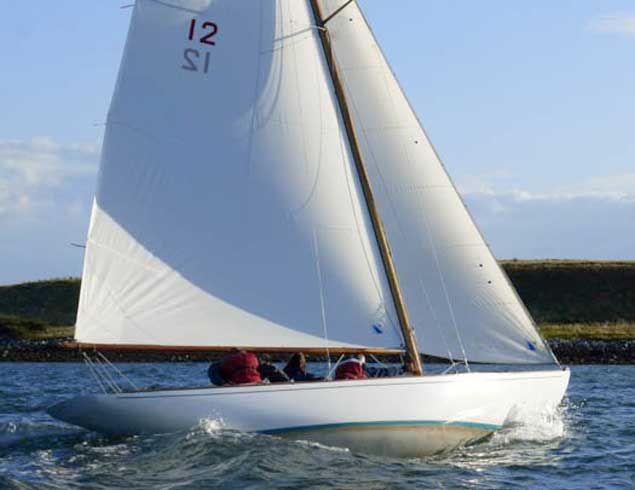 Strangford Lough River Class – designed by Alfred Mylne in 1920, they are believed to be the world’s first Bermudan-rigged One Design. Photo: W M Nixon
Strangford Lough River Class – designed by Alfred Mylne in 1920, they are believed to be the world’s first Bermudan-rigged One Design. Photo: W M Nixon
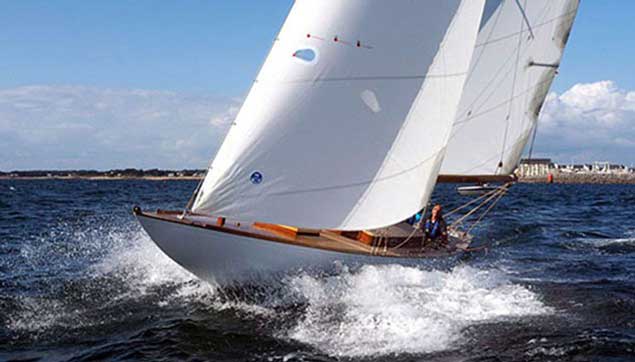 The Dublin Bay 24 Periwinkle, an Alfred Mylne design of 1938, was restored in France
The Dublin Bay 24 Periwinkle, an Alfred Mylne design of 1938, was restored in France
The attraction of such a good selection is that anyone minded to re-create a classic with a distinguished design and sailing provenance can choose a boat of manageable size from the range available in Ireland. A genuine classic doesn’t have to be a biggie. Keeping it manageable – and in many cases keeping it comfortably trailerable – is the secret of a harmonious project, and the eclectic list of classic projects available for sourcing in Ireland not only offers boats of every size and type up to 40ft, but you can come to Ireland and absorb the atmosphere of the places where the idea of the boat was first conceived, and meet current enthusiasts for sailing the boat which gives a vibrant connection both to the present and the past.
Don’t assume, though, that though it may be happening abroad, there’s nothing going on in Ireland. On the contrary, the possibilities of the Irish classics have been exploited every which way. Serial classics enthusiast Hal Sisk of Dun Laoghaire has instigated so many projects that it’s difficult keeping track, but his CV includes the Peggy Bawn, new Water Wags built in classic style, glassfibre Colleens from an 1897 design, and currently the building of a Dublin Bay 21 from the original ballast keel upwards by Steve Morris of Kilrush, utilising multi-skin construction based on laminated frames.
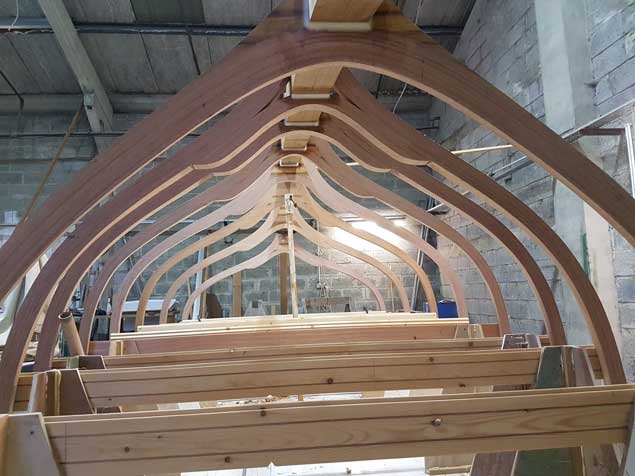 New life for the 1902-designed DB 21 Naneen in Steve Morris’s workshop in Kilrush. Photo: Steve Morris
New life for the 1902-designed DB 21 Naneen in Steve Morris’s workshop in Kilrush. Photo: Steve Morris
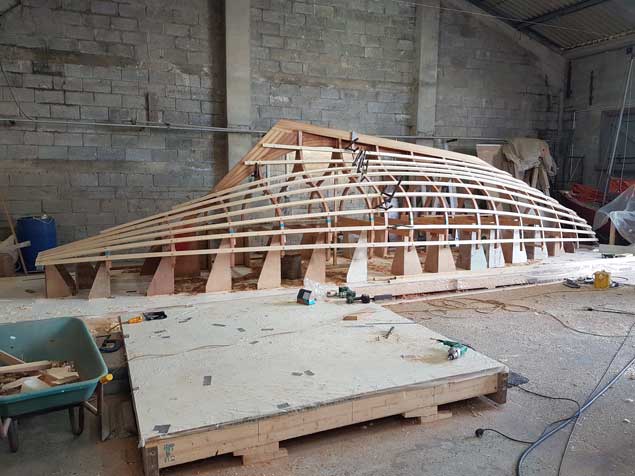 The construction method may be new, but that’s undoubtedly the classic hull of a DB 21 emerging in Kilrush. Photo: Steve Morris
The construction method may be new, but that’s undoubtedly the classic hull of a DB 21 emerging in Kilrush. Photo: Steve Morris
As for Jimmy Furey on the Roscommon shores of Lough Ree, his examples of completely traditional classic style construction of Shannon One Designs and Water Wags – working most recently with Cathy MacAleavey – results in what can only be described as Chippendale work, while down in Ballydehob in West Cork there’s a whole nest of classic restorers, with Rui Ferreira setting quite a pace with new Ettes, a restored Kim Holman Stella, and a much-revived Howth 17.
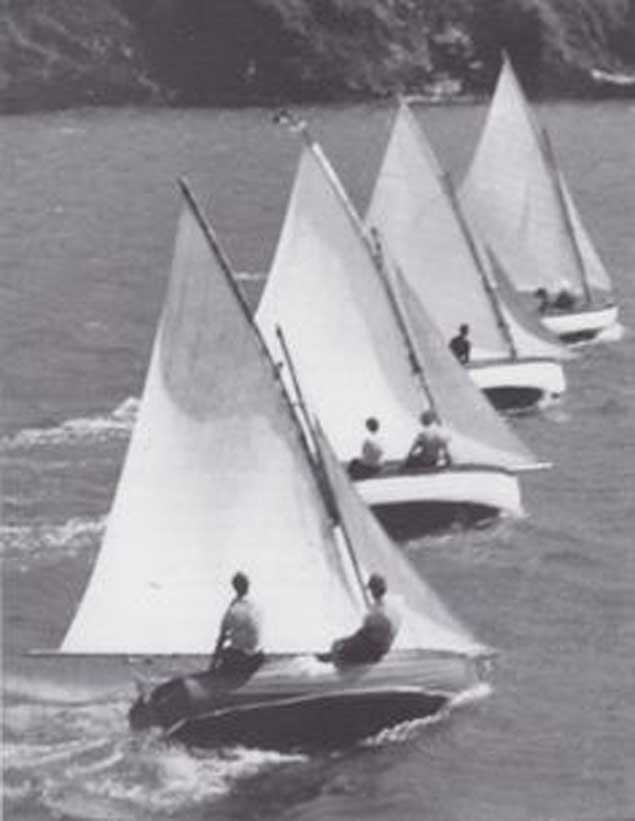 The Castlehaven Ette Class – Rui Ferreira has been building to this design
The Castlehaven Ette Class – Rui Ferreira has been building to this design
Over on the east coast, when times are hectic in classic boatbuilding, people have found that John Jones over in Anglesey does a very good line in stylish clinker construction, but the venerable Howth 17s – not all of which are operated on large budgets – are currently being kept going by Larry Archer of Malahide, who has a workshop up-country where three of these golden oldies are currently receiving the TLC.
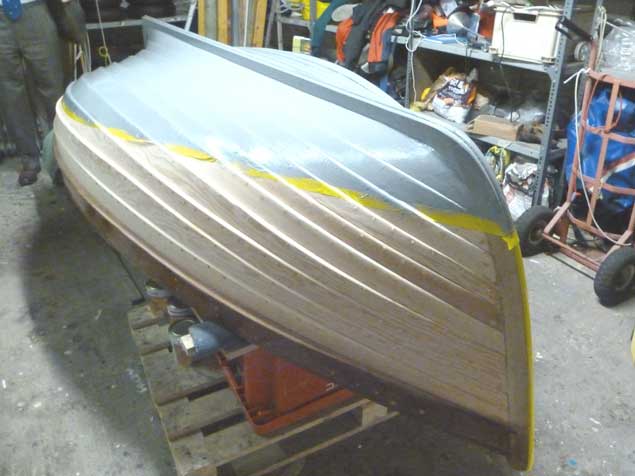 Asgard’s dinghy was re-created in classic style by Larry Archer. Photo: W M Nixon
Asgard’s dinghy was re-created in classic style by Larry Archer. Photo: W M Nixon
Larry is something of a renaissance man in the boat maintenance, repair and building arena, as he is right up to speed with everything to do with glassfibre, yet when Pat Murphy and his group got together to re-create Asgard’s dinghy, it was Larry Archer who delivered the goods, beautifully built in classic clinker style.
As to his present work with the Howth 17s, that is part of a broader project being driven by Ian Malcolm and fellow Seventeen sailors, who may be looking at a class of 23 boats in the foreseeable future. Apart from the new boat built last year in France and the boat reputedly under construction in Annapolis, in a secret workshop on the Hill of Howth, yet another new Howth 17 is quietly under construction to a very high standard.
Such things take time, as the group in Clontarf Y & BC demonstrated when they set out to build a classic timber IDRA 14 for the class’s 70th Anniversary in 2016. They allowed themselves plenty of time, but it was tight enough in the end, yet by the successful conclusion a special bond had been formed among the build team in their Men’s Shed enterprise. It said everything about the deeper benefits of getting involved in a manageable project using time-honoured methods and traditional materials to create something of lasting beauty, value and utility.
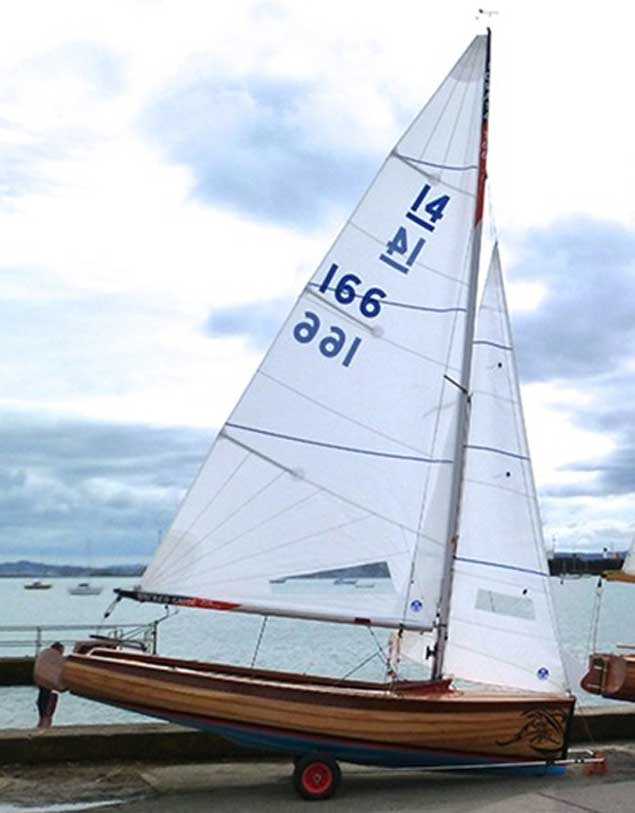 The new IDRA 14 ready for launching at the class’s 70th Anniversary Regatta at Clontarf. Photo: W M Nixon
The new IDRA 14 ready for launching at the class’s 70th Anniversary Regatta at Clontarf. Photo: W M Nixon
Three Mermaid Bullets for Boylan at Rush Sailing Club Regatta
The annual Mermaid Rush Regatta took place this weekend with two races held on Saturday the 26th and one race on Sunday the 27th. With a very light forecast given it was looking uncertain whether any racing would be going ahead at all but thankfully a nice breeze filled in and all 3 races were completed as scheduled thanks to an excellent job by Race Officer Liam Dineen and his team.
Download overall results below.
Saturday saw 11 Mermaids heading out to the racing area, navigating the narrow channel out of Rush Sailing Club with a coming tide to wake everyone up! As the majority of boats made their way out more Mermaids began to appear on the horizon, some of the Skerries crew had arrived, sailing ‘around the corner’ to take part. A total of 15 Mermaids got away on a clean start for race 1 and Mark Boylan on 177, This Is It got a great lead from the beginning. Paul Smith on 134 Jill gave him a good race but Mark held onto his lead securing him his first bullet of the day with Paul finishing 2nd and Foynes boat 119, Three Chevrons getting third.
It was fantastic to see an all-female Mermaid competing on the day, number 192 from Rush Sailing Club helmed by Brenda McGuinness with crew Cara McAuley and Ciara Monks who had a brilliant race finishing in 6th place.
Following the first race, a shifting wind and turning tide meant some decisive action was needed from the race committee in order to get a 2nd race in. The race area was moved significantly and once the wind finally decided to stay more or less put allowing a course to be set, a 2nd race got underway with minimal delay. The 2nd race presented a totally new set of conditions and challenges for competitors and it seemed those that banked hard-right up the beat came out on top. Boylan knew exactly where he was going, tacking onto port more or less straight off the line and even ducking a few boats to ensure he got out to the right hand side as early as possible. It paid off hugely and he was again in the lead to the first windward mark.
There was some great close racing amongst the rest of the fleet and it was brilliant to see newcomer to the Mermaids, Darrach Dineen on 36 Elizabeth, finishing in 5th place for this race. Boylan proved uncatchable securing his 2nd bullet for the day with 134 Jill again in 2nd place and local boat 190 Enda Weldon had a great race making up the top 3.
Sunday the 27th saw a lovely breeze of 10-12 knots, beautiful sunshine and mostly flat seas for the third and final race of the regatta. An extra Mermaid joined the fleet for the day, Jonathan O’Rourke on 77 Tiller Girl had come from the National Yacht Club bringing the total number of Mermaids competing up to 16. Boylan on 177 was again in the lead at the first windward mark but 119, Three Chevrons was hot on his heels and a great race ensued between the 2 boats. While Three Chevrons hugely closed the gap, Boylan proved his skill and racing knowledge, holding him off and securing first place, winning him the regatta overall with a flawless 3 bullets.
While 177 and 119 had been battling for 1st place, crafty fox Jonathan O’Rourke had snuck up in the background and expertly called the layline on the finish just pipping 119 to it and getting 2nd place. Speaking to Vincent Mc Cormack from 119 after the race, he described himself as ‘traumatised’ and ‘robbed in broad daylight’ by the light-air ninja Jonathan:
“He only came up here to ruffle everyone’s feathers, he wasn’t even racing yesterday. He should be handicapped when the wind is this light, I was robbed blind! One minute he’s back the fleet and you’re not paying attention to him, then before you know it you’re tacking for the finish and he’s ahead of you, he needs to be monitored, it’s not natural”.
Overall it was an excellent race with a lot of Mermaids finishing within seconds of each other. Final results on the day: Mark Boylan 177 in first place, Jonathan O’Rourke 77 in second and 119 Three Chevrons finishing 3rd. Jill 134 had battled with Jonathan 77 for the majority of the race and secured 4th place. With two seconds and a fourth, 2nd place overall went to Paul Smith on 134 Jill and 3rd place overall at the Regatta went to Vincent Mc Cormack on 119 Three Chevrons.
Congratulations to Mark Boylan with his crew Cliodhna Connolly and Aileen Boylan (crewing Saturday) and Andy Sexton (crewing Sunday) and well done to all involved. It was a great weekend of racing and a perfect way to close out the 2017 season for Mermaids. Congrats also to Anthony Weldon who won a voucher from Mermaid class Sponsor Union Chandlery. While this was the last big event for the Mermaids, club racing will continue for September and even up until October for some clubs with the class.
Two-in-a-Row for Reigning Mermaid National Champion
Following a tough, initial 4 days of racing at this year’s Dublin Bay Mermaid National Championship at Skerries Sailing Club the 2 remaining days saw the leaderboard again changing daily. Ultimately in what was a very close finish, reigning Champion and local boat 189 Azeezy, helmed by Sam Shiels with crew Con Bissett and Eoin Boylan proved victorious and managed to retain their title for the 2nd year running. Download results below.
Just pipped to the post was 77 Tiller Girl from the National Yacht Club helmed by Jonathan O’Rourke with crew Carol O’Rourke and Alan O’Rourke who finished 2nd overall and who had been leading coming into the final race of the Championship. With only 1 series point between the 2 top boats, Jonathan certainly didn’t make it easy but Sam won out in the end with all of his 8 final, counted results as top 5 finishes. Third place overall was won by Foynes boat, 188 Innocence helmed by Darragh Mc Cormack with crew Mark Mc Cormack and Johnny Dillon. With a breezy first day to the Championship, Darragh had gotten his event off to a cracking start and had been leading overall up to day 3 but the light airs that set in and dominated the majority of the racing made it next to impossible to keep the likes of 77, 189 and 186 at bay.
Outside of the overall National title, 2 other coveted trophies were being raced for during the week including the Daphne trophy and the Designer. Again, in testament to how close the racing really was, both these trophies were still to play for coming in the final day of racing on Friday the 11th of August. The overall winner of the Daphne trophy was 134 Jill from the Royal Irish Yacht Club helmed by Paul Smith with crew Anne Smith and Pat Mangan.
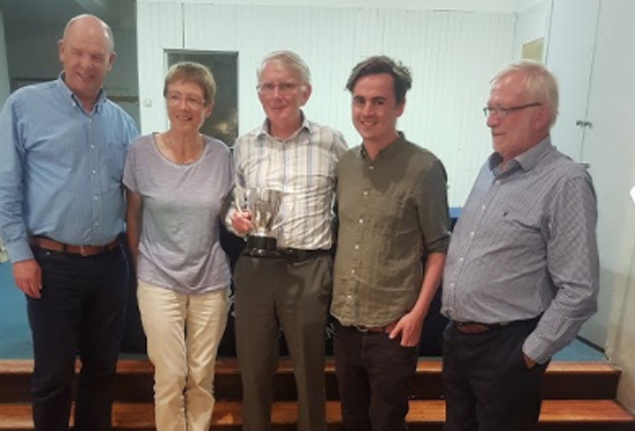 Winners of the Daphne Cup, from left to right, MSA President Des Deane, crew Anne Smith, helm Paul Smith, crew David Weldon and crew Pat Mangan
Winners of the Daphne Cup, from left to right, MSA President Des Deane, crew Anne Smith, helm Paul Smith, crew David Weldon and crew Pat Mangan
The Designer overall was won by another local Skerries boat, 146 Fugitive helmed by Paul Browne with crew Brendan Dunne and Jennifer Shiels. Many people remarked on how much this particular boat improved over the course of the Championship with Fugitive finishing 13th overall in a very competitive fleet of 26 and securing 2 top 10 finishes during the Championship.
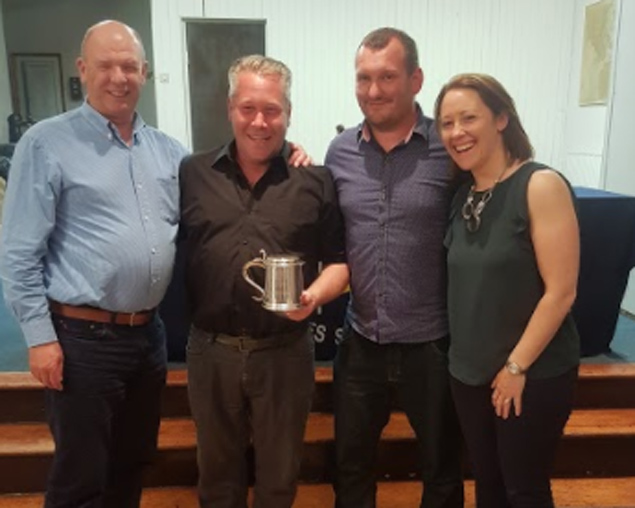 146 Fugitive, overall winners of the Designer tankard. From left to right, Des Deane, MSA President, Paul Browne helm, crew Brendan Dunne and Jennifer Shiels
146 Fugitive, overall winners of the Designer tankard. From left to right, Des Deane, MSA President, Paul Browne helm, crew Brendan Dunne and Jennifer Shiels
Leading into the final day of Championship racing, Shay’s Alternative Prizegiving on Thursday evening in the club was especially welcomed. A night of classic Mermaid-style entertainment was held at the club including Mr. & Mrs (the crew edition) and simulated start lines involving crews in conga lines and fancy dress. All the competitors had a great laugh and it was a perfect opportunity to relieve stress and nerves going into the final day of racing.
Friday the 11th of August saw one final Championship race in windy and gusty conditions that decided the overall winners. Thankfully there were no capsizes (although a few close calls!) but a broken boom and a broken tiller saw 2 boats knocked out of the race and 2 boats OCS all kept the results interesting. With fresh, windy conditions, Foynes boat, 188 Innocence won the race with a considerable lead securing him 3rd place overall. Coming back in from the race area, an elated crew from 189 Azeezy jumped in and swam to shore in celebration of their win!
That evening the well-known prize giving dinner took place at Skerries Sailing Club with every seat in the house full. Daily prizes were first awarded followed by great speeches from Skerries Commodore Kieran Branagan and Skerries Mermaid Class Captain Brian McNally. Glass prizes for 1st, 2nd and 3rd place overall were then presented by the club followed by the overall winners of the Daphne and Designer. Then it was over to the Mermaid Sailing Association President Des Deane to award the coveted perpetual trophies and some prizes from class sponsors. A brand new pair of Dubarry Ultima Sailing boots was won by Brendan Martin and newcomer to the fleet Del Brennan won the top prize of the night: a brand new UK McWilliams Mermaid jib presented by Graham Curran. Graham who had been out watching racing that day had some lovely words to say about the uniqueness and fantastic atmosphere of the class and was delighted to see the new sail go to such an enthusiastic and well-liked member of the Mermaid fleet.
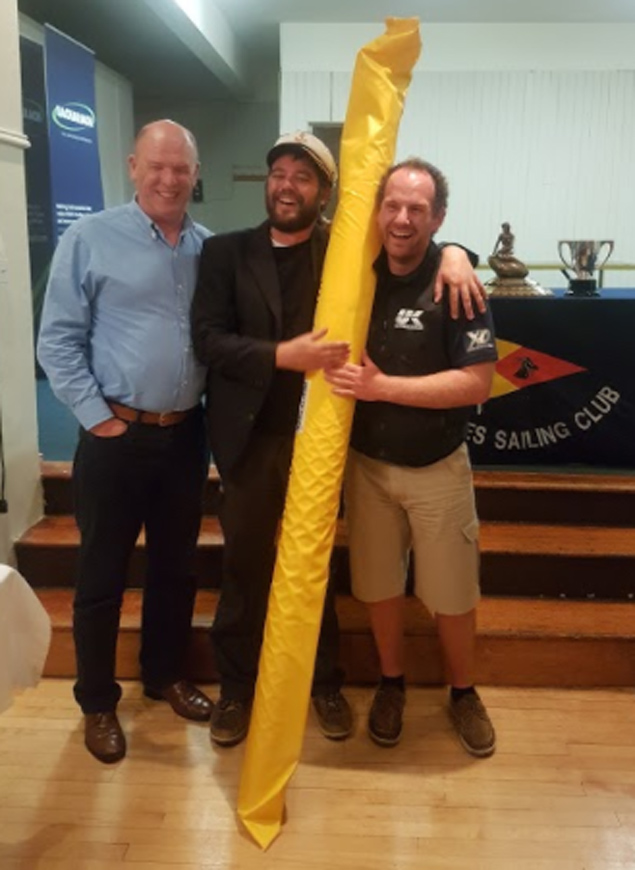 Del Brennan of 173 Jubilee is the lucky winner of a brand new UK McWilliams Mermaid jib presented by Graham Curran (right)
Del Brennan of 173 Jubilee is the lucky winner of a brand new UK McWilliams Mermaid jib presented by Graham Curran (right)
With the designer tankard awarded to 146 Fugitive and the Daphne cup to 134 Jill there was one final presentation to make and the Mermaid perpetual trophy was awarded to 189 Azeezy for the 2nd year in a row. Sam with crew Con and Eoin made their long walk from the back of the club to a huge applause and standing ovation and Sam gave a fantastic speech thanking his club, the class, his family and crew among others.
The next and final event on the 2017 Dublin Bay Mermaid calendar is less than 2 weeks away at Rush Regatta on the 26th and 27th of August.
This week sees Skerries Sailing Club hosting the 2017 Dublin Bay Mermaid National Championship for what is the classes 85th anniversary year. With 26 entries in this beautiful one design class, the past few days have seen all types of conditions thrown at competitors. A practice race on Saturday the 5th gave everyone a chance to get tuned up and ensure their boats were floating! Download overall results below to date
Things quickly got serious with the first days Championship racing on Sunday the 6th which saw lively conditions and 2 full races completed as scheduled. The two bullets on the day went to 123 Vee, helmed by Jim Carthy from Rush Sailing Club and 188 Innocence, helmed by Darragh Mc Cormack from Foynes Yacht Club. Both these boats are known to love the heavier conditions and it showed on the day. As far as records show this was a milestone day for Foynes Mermaids as Darragh secured the first ever National Championship bullet for a Foynes boat.
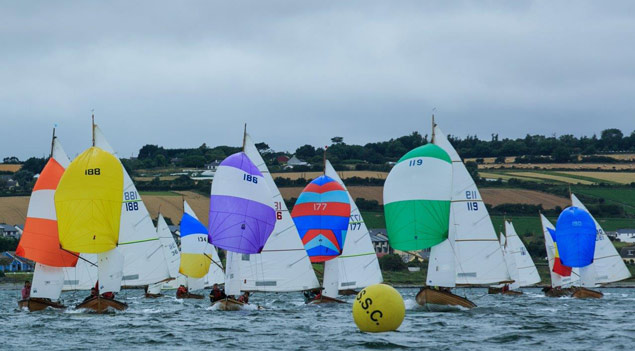 Mermaid dinghies reach into a gybe mark at Skerries Photo: Michael O'Connor
Mermaid dinghies reach into a gybe mark at Skerries Photo: Michael O'Connor
Cliodhna O’Leary from Skerries Sailing Club has been out on the water documenting the action over the past few days and had the following to report on days 2 and 3 (Monday the 7th and Tuesday the 8th):
Monday the 7th of August saw day 2 of the Mermaid National Championship taking place at Skerries Sailing Club. With 2 races planned, the day started off in bright sunshine with the race committee of Liam Dineen and his team setting their course early so the start was on time in tricky conditions which were very light and shifty. The right side of the first beat paid off with 135 Frankie Browne rounding the first mark in the lead with 190 Enda Weldon and 179 Conor O'Toole in hot pursuit. It was lovely to see number 100 helmed by Anna Lowes from Foynes Yacht Club in 7th at this stage. Frankie in 135 led from the 1st mark rounding to the finish securing himself a well deserved National bullet, with last year’s Champion 189 Sam Shiels making his way through the fleet after a slow start to get second place. Enda in 190 held on for 3rd with 177 Mark Boylan and 119 Vincent McCormack making up the top 5.
With the SW wind coming off the land fading conditions became even more difficult for the second race. Former champion Jim Carthy 123 described conditions on the start line as some of the most difficult he had ever sailed in. Both sides of the beat appeared to have 'holes' causing frustration levels to rise! The very experienced Jonathan O'Rourke on 77 Tiller Girl rounded the weather mark first followed by 185 Ross Galbraith second and 189 Sam Shiels third. With the wind fading and the strong ebb tide kicking in it looked as if the race would have to be abandoned but a light sea breeze spread across the course and 77 Jonathan was away round the next weather mark. With the tide under him he opened up a large lead and with the other boats struggling to round the weather mark he was away. The race committee decided to shorten the course at the next weather mark with the resulting top 5 as follows: 1st 77 Jonathan O’Rourke, 2nd 189 Sam Shiels, 3rd 188 (Darragh McCormack overall leader after day 2), 4th 134 Paul Smyth and 5th 186 Brian McNally.
Day 3, Tuesday the 8th of August started in glorious sunshine with a light NW breeze. After a close start across an even start line 77 Jonathan O'Rourke showed a clean pair of heels up the first beat.
Coming round after the first triangle 77 was still in the lead but with 189 Sam Shiels closing in with these 2 opening up a big gap. Shay O'Toole in 182, one of the oldest sailors in the fleet, rounded the mark third and overall had a fantastic race which won him the daily Daphne prize. The wind held true and these three finished in the same order with 186 Brian McNally and 188 Darragh McCormack making up the top 5.
Following one Championship race on Tuesday, the crews race immediately followed with a great turn-out of 14 boats taking part. It was fantastic to see so many young helms taking the command and the winner was Frank Browne (jnr) helming Jonathan O’Rourke’s boat no. 77, Tiller Girl.
Wrapping up on Tuesday the 8th after 5 championship races (with one discard) the leading positions were Sam Shiels, Azeezy no. 189 in first place on 9 points, Darragh Mc Cormack, Innocence no. 188 in second place on 11 points. Jonathan O’Rourke in third place on Tiller Girl no. 77; fourth is Vee no. 123 and fifth is Cara II no. 135.
Day 4, Wednesday the 9th of August again gave tricky conditions for competitors with light, shifty wind. Past Champion Jonathan O’Rourke on 77 Tiller Girl cemented his well known reputation for loving the shifty, light airs securing 2 more bullets pushing him well up the leaderboard in 2nd place overall. With very little wind, a big swell and the tide turning halfway through the racing a lot of people found it hard to stay consistently up at the top. In the second race the wind dropped off that bit too much and the Race Committee made a welcome decision to shorten course following the second run.
With cracking sunshine at Skerries Sailing Club following the day’s racing, Roisin Mc Cormack, MSA Captain spoke to local competitor Mark Boylan on how he had been finding the first few days racing:
“Overall really good racing, tricky conditions but great courses and very competitive fleet. It would be nice to see a bit more wind for the final 2 days, it’s shaping up to be a close finish for everyone” - Mark Boylan 17, This Is It, Skerries Sailing Club.
Liam Dineen, the National Race Officer for the event also had the following comments on the past few days and his hopes for the final 2 days Championship racing:
“We’re hoping for a very competitive series and very close racing. We have been delighted to get all races in so far as scheduled. We’ve had very fast turnaround between races and I think it’s the first time that I can remember that the crews race went ahead in it’s scheduled spot, and it was great to see 14 boats out for this. We would hope for a bit more wind which we know is coming Friday but we would like to have one of those better days of racing on Thursday. It’s still looking light so we’ve delayed the racing to 2pm tomorrow in hope that we’ll have more breeze. It’s great to see more younger members of the fleet coming through again for example Mark Boylan, Conor O’Toole, Paul Browne, Darragh Mc Cormack. And having new faces to the fleet like Darrach helming 36 Elizabeth. It’s great to have the owner of Elizabeth on one of the mark boats getting to see his boat being sailed. Overall the weather is great and proving very hospitable with plenty of sunshine and we’re delighted to have all the Mermaids back in Skerries for this special anniversary Nationals” - Liam Dineen, National Race Officer
With only 2 overall series points between them, Sam Shiels (17 points) and Jonathan O’Rourke (19 points) are currently battling it out to win the coveted title. A strong performance from Foynes boat, 188 Innocence sees him lying third and still in with a chance to come back into the running with 25 points. The next 2 days will be the decider and with the racing postponed until 2pm tomorrow instead of the usual starting time of 12 there are hopes more wind will fill in for the 2 scheduled races tomorrow.
Tomorrow, Saturday the 5th of August will see the 2017 Mermaid National Championship kick off with registration and a practice race at Skerries Sailing Club for what is the 85th anniversary year for the class.
An online entry form encouraging competitors to register for the event in advance saw a fantastic 27 entries sign up from six different clubs including Rush Sailing Club, Foynes Yacht Club, Royal Irish Yacht Club, National Yacht Club, Clontarf Yacht and Boat Club and Skerries Sailing Club. A number of past, well-known faces to the class are making a welcome return including past National Champion Mark Boylan on 177, This Is It and Andrew Frazer on 174, Golden Chevrons among others. New to the class include Darach Dinneen on 36 Elizabeth, Del Brennan on 173 Jubilee and number 4 Ferga from Clontarf Yacht and Boat Club. It is a very welcome return of Mermaids from Clontarf to the fleet. This year, not one, but two Mermaids came back to Clontarf (number 4 Ferga and Ciaran Hynes’ number 17 Maeve) through a fantastic initiative and drive from Clontarf Yacht and Boat Club, no doubt they will get a very warm reception at this year’s main event.
With a practice race tomorrow to get everyone tuned up and ready, the real Championship racing starts on Sunday the 6th when a 10 am briefing will kick everything off. Racing covers a full 6 days and runs right through to Friday the 11th of August with a total of 10 Championship races planned as well as one Crew’s race (where one of the crew helms). Shoreside entertainment includes an RNLI quiz at 8pm on Tuesday the 8th as well as the famous ‘Shay’s Alternative Prize Giving’ on Thursday the 10th also starting at 8pm at Skerries Sailing Club. The final Friday night on the 11th will see the new National Champion crowned in and at this stage with so many competitive boats in the fleet it’s very difficult to predict who this will be. Along with daily prizes for 1st place helm and crew, 1st place Daphne helm and crew and 1st place Designer helm and crew there will also be daily raffles hosted by the Mermaid Sailing Association. These raffles are thanks to the MSA’s generous sponsors including UK McWilliams Sailmakers, Dubarry of Ireland, North Sails and Union Chandlery and all competitors will be included in daily draws for some great prizes.
The forecast which had been giving very light winds seems to be picking up and at the moment it’s looking good for the scheduled racing (although we all know how quickly that can change!). Keep an eye out for further update articles on Afloat.ie as the Championship progresses and best of luck to all taking part.
Veteran Wexford Boat Builder to Celebrate 90th Birthday
One of Wexford's leading timber boat builders Larry Duggan, of the The Moorings, Carcur, will celebrate his 90th birthday shortly.
Duggan has been constructing wooden craft for over seventy five years.They include three Dublin Bay Mermaids,Wexford Sailing Cots, Work Boats, numerous Shooting and Pleasure Craft.
He was commissioned By Christian Brown OBE KSG to construct a bespoke Scandinavian Design Pram for HRH The Queen's Silver Jubilee Celebrations as part of the
River Thames Flotilla. His sailing and nautical skills have been recognised and he is the recipient of the 'Maritime Medal.'
Larry's in depth knowledge and participation in sailing both inshore and offshore, shooting, fishing and ornithology on the Southeast Coast of Ireland and has contributed to a a number of publications.
Happy Birthday, Larry from all at Afloat.ie!
Clinker Mermaids Get a Great Warm-Up at Skerries Regatta
Last weekend saw the annual Skerries Regatta take place over Saturday and Sunday the 15th and 16th of July. With an ambitious six races planned (3 per day), an impressive fleet of 18 Mermaids took to the water, completing 5 races in total. The Regatta offered a variety of conditions and consistency was key for the top winners.
With the Mermaid’s annual National Championship being hosted by Skerries Sailing Club this year from the 5th to the 11th of August, it’s not surprising that the turnout was so good as many availed of this perfect opportunity to get some invaluable practice in for the main event.
Saturday the 15th of July saw some competitors struggle to make it out to the starting area with a low tide that wasn’t filling in fast enough making it very difficult for a number of boats to launch, as a result some Mermaids missed the first race. Competitors were met with a strong, fresh breeze and relatively flat seas as they made their way out to the race area promising for some excellent conditions. Sharing the course were the Fireballs that zoomed around in their element racing for their Leinster Championship (see Fireball report here) as well as some yachts and various dinghies and e-boats. The first race got off to a clear start on schedule and it seemed that those that played the middle of the beat and then banked out to the right came out on top. Darragh Mc Cormack on 188 Innocence took 1st place with Sam Shiels on 189 Azeezy in 2nd and Vincent Mc Cormack on 119, Three Chevrons finishing 3rd.
Following the first race, the breeze picked up considerably and conditions were much more demanding for the second race of the day. The telltale sign was that, bar the top 3 boats, no other Mermaids flew their spinnakers once they had rounded the first windward mark. Frankie Browne on 135 Cara II was having a spectacular race and was lying 2nd, hot on Darragh Mc Cormack’s heels. Eye witnesses claimed the speed Frankie got up to on one of the reaches was the closest a Mermaid had ever come to foiling! The rush of it all must have went to his head as despite the breeze continuing to build on the next leg, Frankie again threw up the kite but unfortunately took a slip and ended up overboard knocking him out of Race 2! Three Chevrons who were right behind Frankie took up the challenge of catching Darragh Mc Cormack and a fantastic race between Uncle and nephew ensued. Three Chevrons managed to climb into the lead on the beat of the last triangle and under the impression that Darragh would most certainly be putting up the kite to get back into 1st place, Vincent threw his up without question (despite the breeze now being well up in the 20’s gusting higher). A bad squall at bad timing was one step too far for Three Chevrons and their 7 year old mast had had enough! A pretty clean break stopped the speed-hungry Three Chevrons in their tracks and Darragh went on to secure another bullet. 123 Vee helmed by Jim Carthy snatched up the 2nd place spot and a fantastic race out of up-and-coming Paul Browne on 146 Fugitive saw him finish in 3rd for what was a very demanding race to even finish. With the wind building and 2 mermaids now with broken masts, the Race Officer made the wise decision to call it a day and the fleet headed back to the club for a fantastic BBQ spread enjoyed on the sunny balcony overlooking the harbour.
Sunday the 16th saw somewhat calmer conditions but still with a great breeze for racing with lovely flat seas and plenty of sunshine. A strong fleet of Mermaids headed out for an 11am start and managed to get all 3 races in. Darragh Mc Cormack who was leading overall got another bullet in race 1 but it was closer racing with some great displays from the likes of Ross Galbraith on 185 who finished 2nd and reigning National Champion Sam Shiels who finished 3rd. Indeed Sam seemed to have found his rhythm as he went on to get 2 firsts in the remaining 2 races of the day pushing him up to finish 2nd overall. The racing in the fleet seems to have a great calibre of competition this year with a number of strong boats always appearing in the top 5 and plenty of others climbing the ranks so the Nationals should be very interesting to see who will claim the coveted title.
Having already won the Mermaid Munster title, ICRA Class 4 in both IRC and Echo on his J24 Stouche as well as the J24 Southern's, Darragh Mc Cormack from Foynes Yacht Club continued his winning streak with his Mermaid 188 Innocence finishing 1st overall at this year’s Skerries Regatta. All of these wins are hard fought and this event was no different, reigning National Champion and local boat, 189 Azeezy helmed by Sam Shiels finished 2nd place overall with only 2 additional series points behind Darragh. Third place overall went to 123 Vee helmed by Jim Carthy and 4th place overall went to 186 Gentoo helmed by Brian Mc Nally. The event overall was a great warm-up for the fleet and now it’s all eyes on the Nationals with volunteers, competitors and everyone in between busy in preparations for the 5th of August.
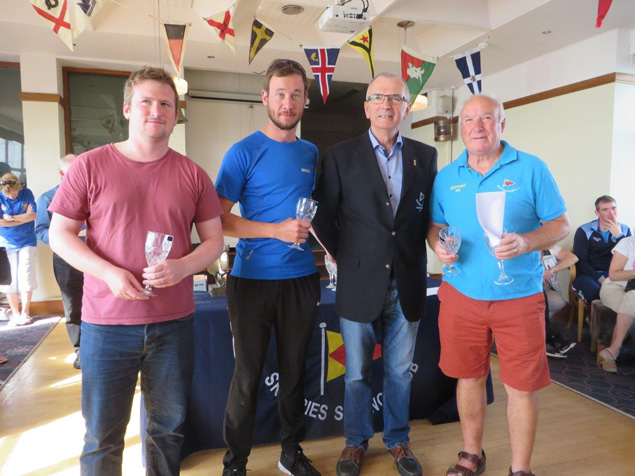 Second place overall goes to reigning National Champion and local Skerries boat Sam Shiels on 189 Azeezy with his crew Doire Shiels and Peter Bissett
Second place overall goes to reigning National Champion and local Skerries boat Sam Shiels on 189 Azeezy with his crew Doire Shiels and Peter Bissett
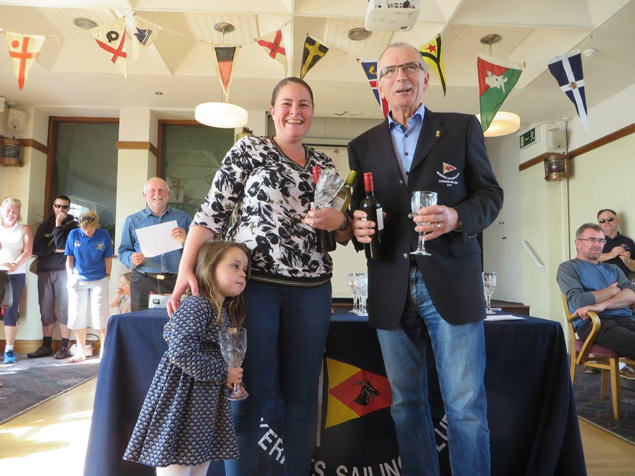 Third place overall goes to 123 Vee helmed by Jim Carthy with crew Paula and Muriel Carthy from Rush Sailing Club
Third place overall goes to 123 Vee helmed by Jim Carthy with crew Paula and Muriel Carthy from Rush Sailing Club
Skerries Ramps up for Mermaid National Championship
Skerries Sailing Club looks back on its strong historical roots with the Dublin Bay Mermaid class in preparation for hosting this year’s National Championship writes Susan Roundtree
This year’s Dublin Bay Mermaid National Championship is being hosted by Skerries Sailing Club from the 5th to the 11th of August. Sailing starts with a practice race on Saturday the 5th and will continue with 6 days Championship racing over the following week from the 6th to the 11th. In total there will be 10 races for the Championship as well as one Crew’s Race.
Shore side activity will be in Skerries Sailing Club where sailors with their families and friends will be welcomed by Commodore Kieran Branagan and all the team involved with running the event. The event rules require the boats to be kept on moorings for the duration of the competition which will be a spectacular sight in the harbour during the week with ample opportunity for spectators and supporters to view racing. Mermaid Week is unique among dinghy fleets as it has a week-long National Championship with a vibrant social and entertainment calendar to match what is usually top-notch, highly-competitive racing. This year marks the 85th anniversary since this classic dinghy design was first presented to the Committee of Dublin Bay Sailing Club by yacht designer John Breslin Kearney.
Mermaids have a very long association with Skerries which has hosted the Championship on eleven previous occasions, for the first time in 1970 and most recently in 2012. This year, in light of the special anniversary and a resurgence of interest in the class, the club is really ramping up efforts to get as many boats as possible out on the race course and Mermaids from Rush, Dun Laoghaire and Foynes are all already confirmed to join Skerries boats. The news of two recently restored Mermaids in Clontarf (Ferga and Maeve) has been warmly welcomed by Mermaiders who hope to see these boats back out racing in Club and Championship events very soon!
The coveted Mermaid Perpetual Trophy will go to the overall winner in what is known as a very demanding and difficult title to win. It takes the form of the Little Mermaid of Copenhagen by Danish sculptor Edvard Eriksen and is cast in bronze, mounted on a wooden plinth which records all the Championship winners since 1953. The current holder is Sam Shiels of Skerries who won the Championship in Howth last year in his Mermaid Azeezy (no. 189). As it happens the 3 main class trophies all went to Skerries boats last year with Brian McNally, in Gentoo (no.186) winning the Daphne Trophy (silver fleet), and Shay O’Toole, in Dolphin (no.182), winning the Designer Trophy.
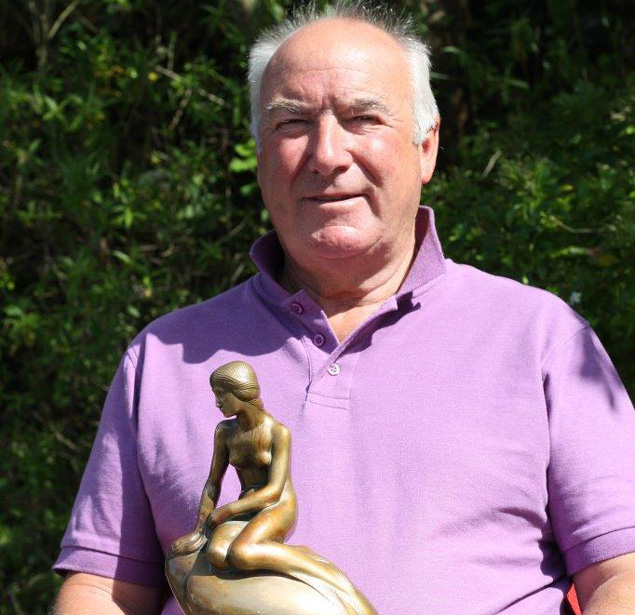 Sam Shiels, the 2016 National Champion with the coveted Mermaid Perpetual Trophy. Photo: Ross Galbraith
Sam Shiels, the 2016 National Champion with the coveted Mermaid Perpetual Trophy. Photo: Ross Galbraith
The Mermaid Perpetual Trophy mentioned above was first presented to the class in 1952 by Norman Hodgson, a founding member of the Mermaid Sailing Association who was also Commodore of Skerries Sailing Club in 1952 and 1953. His own mermaid Rosalie (no. 81) was named after one of his daughters and was one of six boats (nos. 80 – 85) built in the first ever amateur boatbuilding class run by the City of Dublin VEC in what was then known as the Barkyard (later Redmond’s Coal Yard) on the South Strand in Skerries. The remarkable enthusiasm involved in this endeavour gave impetus to the growth of the Mermaid class. The Barkyard itself had originally been the location for the ‘tanning’ or ‘barking’ of the sails of traditional working boats in order to preserve them – the tannin being derived from the bark of the oak tree. The former drying sheds were used for the boat building classes. The names of those early boat builders are synonymous with the history of sailing in Skerries and include; Joe Acton. Kit & Joe Fox, Bobby Carey & Jim Dempsey, Ollie Murray, Matt & and Joe Boylan. Their instructor was Joe Murphy, a member of a well-known boat-building family in Ringsend.
After five years, the return of the National Championship event to Skerries Sailing Club is being warmly welcomed by local members and the community which is not surprising considering how strong its historical ties and links are to the class. This weekend the club will also be hosting its annual ‘Skerries Regatta’ across Saturday and Sunday (the 15th & 16th). Many Mermaids are expected to take part as it is an excellent practice opportunity in advance of the main event.
History credits: The Dublin Bay Mermaid – a history 1932-2000, Paul Smyth, 2001
Mermaids Back in Dublin Bay for VDLR 2017
The 2017 Volvo Dun Laoghaire Regatta saw the return of the Mermaid fleet in impressive numbers to Dublin Bay for the first time in a number of years. 15 Mermaids took part in what was also their Leinster Championship from the 6th to the 9th of July. With their race area at the Salthill mark the first day and South Bull for the remaining 3 days of racing, the fleet got all 10 races in for what proved to be an exceptionally competitive fleet. The leaderboard changed constantly with 3 different boats lying at the top spot after the first three days of racing. Local boat 134 Jill helmed by Paul Smith with his crew Anne Smith and Pat Mangan were leading following the first 2 races on day 1 but this quickly changed following another 3 races on day 2 where Foynes boat, 188 Innocence helmed by Darragh Mc Cormack then found himself in the lead. The 3rd day of racing, again with 3 races, saw the leaderboard move again after Skerries boat 186 Gentoo helmed by Brian McNally played a blinder with a second and 2 firsts that moved him up to first place overall. Ultimately with the lowest points and most consistency across the entire regatta (in what was extremely close racing), the winner was 134 Jill from the Royal Irish Yacht Club.
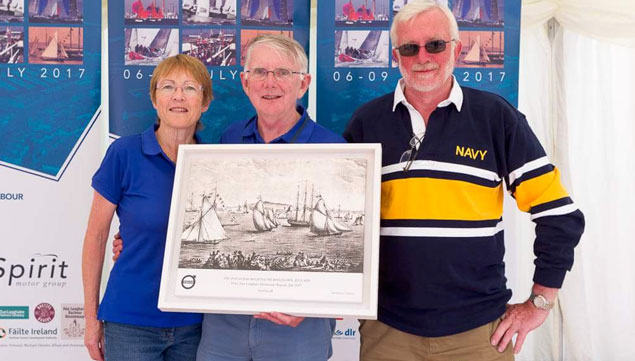 Mermaid winners – Number 134, Jill, from the Royal Irish Yacht Club, (from left to right Anne Smith, Paul Smith and Pat Mangan). The trio are now also the new Leinster Champions Photo: Gareth Craig
Mermaid winners – Number 134, Jill, from the Royal Irish Yacht Club, (from left to right Anne Smith, Paul Smith and Pat Mangan). The trio are now also the new Leinster Champions Photo: Gareth Craig
The Mermaid fleet are used to, for the most part, having Olympic courses all to themselves so sharing with up to 5 other fleets using a mix of inner and outer trapezoids meant the fleet were kept very much on their toes but they stepped up to the challenge! Mostly light winds dominated the majority of the racing and having the local knowledge of the Dublin Bay tides definitely proved an advantage. Having to account for a lot of other boats on the course saw new tactics come into play and those who could use this to their advantage gained big leads (often at the expense of others!). After the racing, entertainment, “the best pints of Guinness ever” and great BBQ food kept the majority of the Mermaid competitors enjoying the social side of things as they are so well known to do.
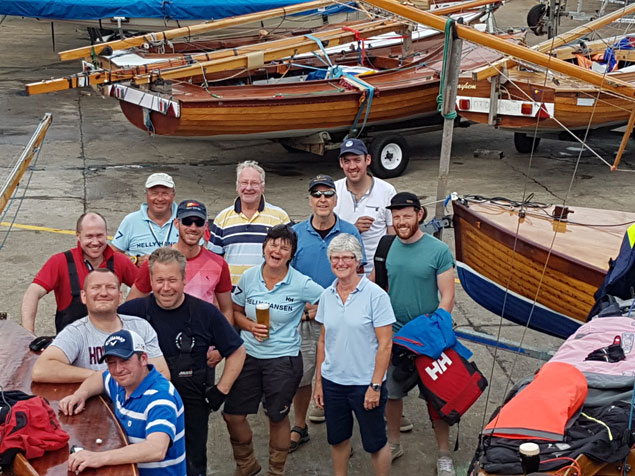 Back to their historical roots of Dublin Bay – Mermaiders in apres-sail mode after a successful VDLR and Leinster Championships at the National Yacht Club
Back to their historical roots of Dublin Bay – Mermaiders in apres-sail mode after a successful VDLR and Leinster Championships at the National Yacht Club
Hosted by the National Yacht Club it was a great return of the fleet to it’s historical roots of Dublin Bay and the consensus from the fleet overall was that it was a fantastic event blessed with great racing, weather, company and entertainment. A big congratulations to the organisers of the Volvo Dun Laoghaire regatta and all 4 clubs of Dublin Bay for what was a brilliant 4 days. The Mermaids are now keen to ensure their next visit won’t take so long!
A big congratulations to the winner 134 Jill now also the 2017 Mermaid Leinster Champion. With hardly time to have their gear washed and dried, the fleet are heading North to Skerries for their annual Regatta this weekend. With their main National Championship event being hosted at Skerries Sailing Club this year from the 5th to the 11th of August, the Regatta is an excellent opportunity for competitors to have a practice run, get to know the race area and get their boats tuned up for the main event, watch this space!
Read more about Dun Laoghaire Regatta 2017 in one handy link here.
Cotton Topsails Hoisted as National Yacht Club Welcomes Classic Boat Fleet for Kingstown 200 Cup
It could be over 50 years since a cotton topsail has been seen from the National Yacht Club and this afternoon as the classic fleet arrived "Peggy Bawn", a GL Watson 36–ft Cutter, built in 1894, hoisted her cotton suit of topsail and gaff main.
A temporary pontoon as been anchored off the Carlisle Pier and here the renovated Dublin Bay 24 footer "Periwinkle" this afternoon having sailed from France via the Scilly's and Greystones where some former 24 hands with long association with the class shipped on board, Chris Johnson, David Espey, Chris Craig and Terry Johnson.
On the National Yacht Club platform the Dublin Bay Mermaids were arriving by road and a fleet of "Fifes" from Royal Anglesey Yacht Club were being masted and launched having arrived by ferry.
The fleets arrival for the opening of the Volvo Dun Laoghaire Regatta and the inclusion of the classics for this edition will provide a historic spectacle from the East Pier.
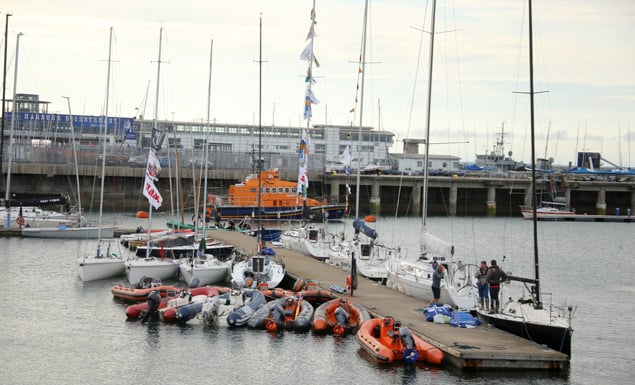 Dun Laoghaire Regatta entries line up at the National yacht club pontoon ahead of tomorrow's regatta
Dun Laoghaire Regatta entries line up at the National yacht club pontoon ahead of tomorrow's regatta




























